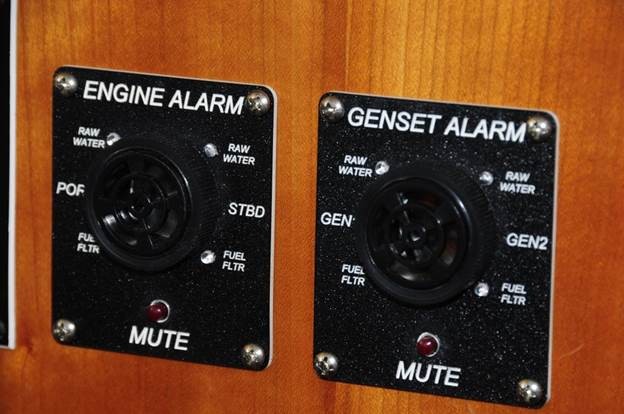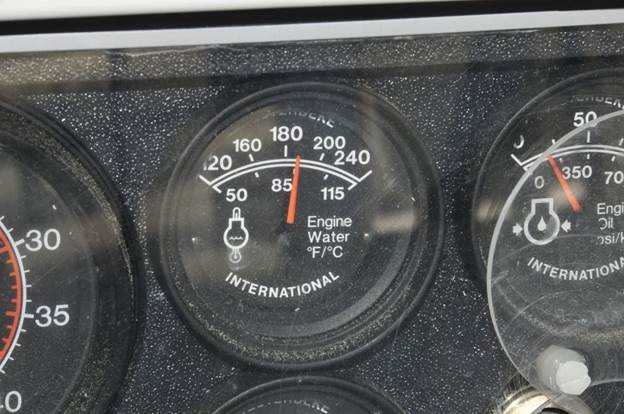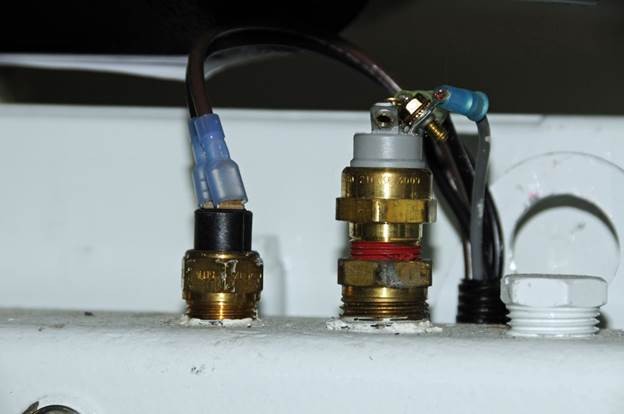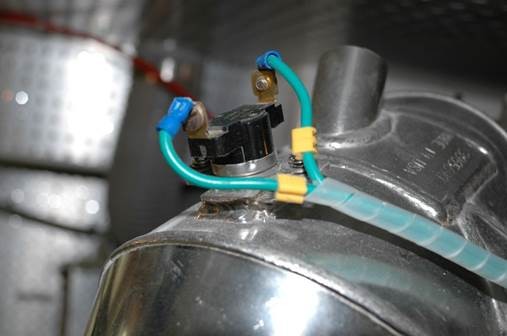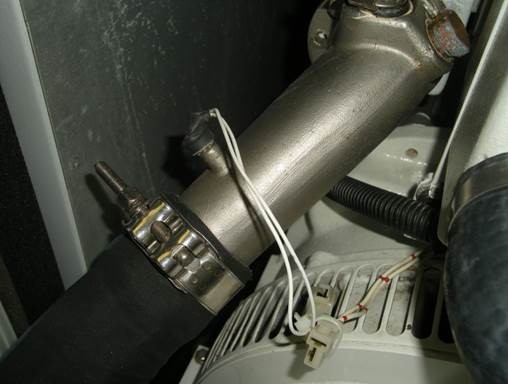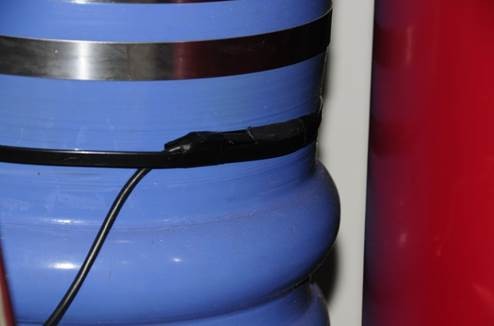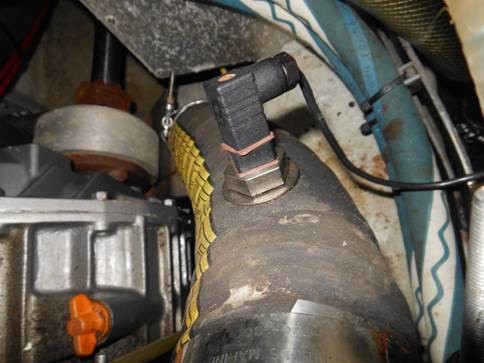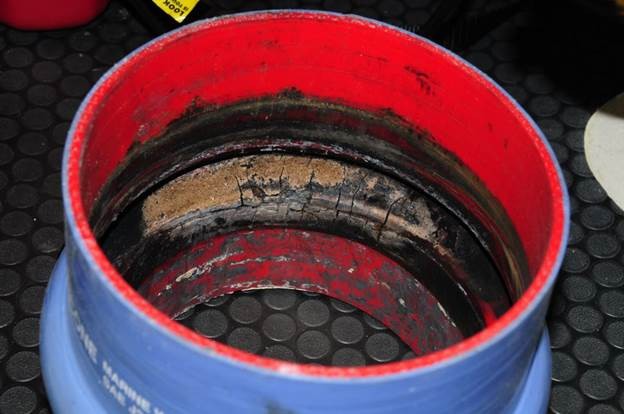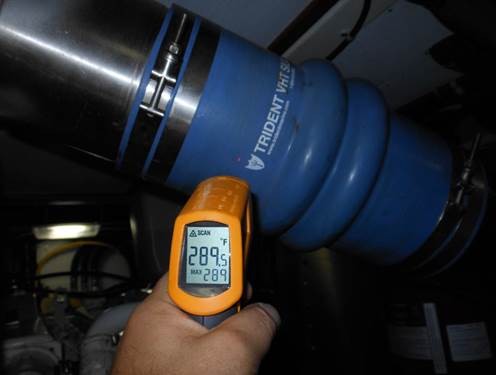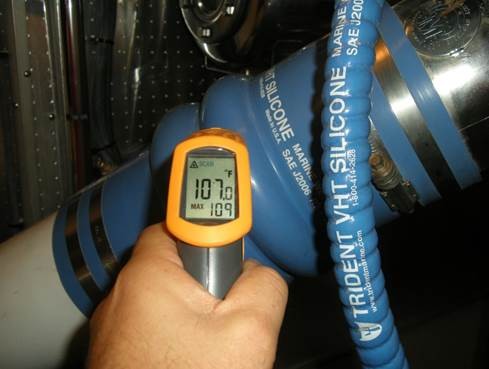Onboard Alarms – Part I
Text and Photos By Steve D’Antonio
Copyright April 2014
Onboard “alarms”fall into a variety of categories and levels of criticality. The alarm panels shown here monitor both exhaust system temperature as well as the accumulation of water in fuel filters, for propulsion engines and generators aboard this vessel. When the audible alarm sounds, an accompanying light quickly alerts the vessel operator as to which component is in need of attention.
A client of mine contacted me and asked about which, if any, alarms he needed to have installed aboard his boat while it was undergoing a refit. The “Which if any” comment caught my attention. Indeed, if there’s one thing a skipper needs while he or she is cruising, be it under way or at anchor, it’s information about the vessel, the propulsion system, generator and the integrity of the hull. A vessel that includes complete, operational systems alarms is less likely to suffer catastrophic breakdowns, flooding, fires and other seaborne calamities as well as being less expensive to operate in the long term.
Engines and Generators
One of the tests I carry out during a vessel inspection involves confirming that the engine’s own integral alarms work. Virtually every marine diesel engine and generator includes, or included when it was originally manufactured an alarm to alert the user to a few key events. Typically, and at the very least, these include high coolant temperature and low oil pressure annunciators. The coolant temperature alarm threshold varies from engine to engine, however it’s typically somewhere around 220°F. Oil pressure alarms also vary; their alarm set point may be as low as 8psi. Generally, oil pressure rarely has an in between failure, either it’s within specifications or it’s zero. Both of these alarm scenarios call for immediate action on the part of the skipper, particularly the latter.
As valuable as engine instruments may be, it’s impossible to monitor them continuously while operating a vessel safely. Engine alarms, including but not limited to coolant and exhaust temperature and oil pressure, fill that gap.
While overheating is never desirable, depending upon the rapidity of the onset of the overheating event, it’s sometimes possible to motor a short distance, to leave a busy channel for instance, before shutting down. Loss of oil pressure, on the other hand, affords the operator no such option. If he or she ignores the alarm for more than a few seconds, the damage will have been done and motoring any distance, no matter how short, is likely to become impossible as a result of engine seizure.
Pressurized lubricating oil forms a wedge of sorts between moving parts such as crankshaft journals, bearings, piston rings and cylinder walls. Four cycle internal combustion engines require this oil wedge virtually continuously in order to operate, without it rapid wear and heat generation ensue. I’ve seen loaded diesel engines grind to a halt, literally, within 10 seconds of a low oil pressure alarm sounding.
The low oil pressure alarm systems on roughly half of the vessels I inspect are not operational. How do I make this determination? Easy, I turn the ignition switch or ignition circuit breaker to the on position (without starting the engine), if I hear no alarm then it’s likely it will not sound in the event of a genuine low or no oil pressure event. This test simply simulates a no oil pressure scenario by energizing the ignition system and, because the engine is not running and thus has no oil pressure the alarm sounds, or should. For electronically controlled engines, mercifully, the test is often a short chirp rather than a continuous piercing wail. Every time you start your engine (this includes electric startoutboards as well) make certain the alarm sounds briefly, if it doesn’t it’s possible it never will; troubleshoot and repair the problem immediately. This test, by the way, is far from definitive in that it makes no determination about the overheat portion of the alarm system. This alarm can and should be tested at least once if it’s never been done and every three years thereafter.
In many cases, if engine alarms don’t exist, senders must be added. Typically, this is not especially difficult; however, consideration must be given to their physical security and the potential for vibration-induced failure.
Generator high coolant temperature and low oil pressure alarms work in much the same way as those described above with one important distinction. When most generators encounter either of thesealarm scenarios they automatically shut down, preventing or minimizing damage. Propulsion engine alarm systems, on the other hand, rarely if ever automatically initiate a shutdown, although some found on modern electronically controlled diesels will reduce rpm to minimize heat generation. The logic being that apropulsion engine shutting down without notice may be more detrimental than the damage caused by overheating or low oil pressure, when docking for instance or crossing ahead of another vessel.
Exhaust temperature alarms are especially valuable, and required for compliance with American Boat and Yacht Council guidelines; the one shown above monitors temperature of the metallic mixing nozzle. Because of its mass this type of alarm can be slow to react.
Most modern generators and those manufactured in the past fifteen years include an exhaust temperature sensor, which will automatically shut down the generator in the event of an exhaust system overheat.
Another alarm, of sorts found on nearly all generators but few propulsion engines is exhaust temperature (like other generator thresholds for low oil pressure or high coolant temperature, rather than sound an audible alarm, the exhaust temperature sensor simply shuts the generator off in the event of an overheat). Typically, engines overheat acutely for one of two reasons, loss of raw water or loss of coolant. In the former case the engine will overheat, although it often takes a few minutes depending upon load. What will happen very rapidly, however, is overheating of the exhaust system, which is cooled with raw water on most inboard engines. The exhaust gasses of a diesel engine can be as hot as 1000°F. At that temperature it takes but a few seconds for damage to occur to normally water-cooled rubber, plastic and fiberglass components. Thus, exhaust temperature alarms are not only highly desirable; they are required for ABYC engine installation compliance.
Exhaust system alarms should be “armed” and ready to sound in the event of an overheat, whenever an engine is running. Powering them via an independent circuit breaker is, therefore, inadvisable as this can too easily be turned off. Ideally, they should be energized from the engine’s own ignition circuit.
Exhaust temperature alarms can be easily retrofitted to nearly any generator or propulsion engine that is not already so equipped. Make certain that alarm annunciators are located at both helm locations and ensure it is loud enough to be heard under all operating conditions. In the case of generators, their manufacture-supplied exhaust temperature sensors will, if triggered, result in an automatic shutdown, but rarely will an audible alarm sound, which I believe is a liability.
Exhaust temperature alarms are available in several varieties, including those that are strapped to the outside of the exhaust hose, those that pierce the hose and those that are fastened to a metallic riser or elbow. They all work, however because of their mass and heat sink properties, those that measure the temperature of a metallic riser are often slower to react to a temperature change than those strapped to the hose or those that actually reside in the exhaust stream by piercing the hose.
Surface mount alarm sensors or thermistors, like the one shown here, offer two attributes, they respond very quickly to temperature change, and they don’t need to be exposed directly to exhaust gasses and water. On diagonal hoses (these are most common), the sensor should be placed along the top of the hose, between 11 and 1 o’clock, to ensure the quickest reaction time. This hose is vertical, which means the sensor can be placed in any position.
Exhaust alarm sensors that must penetrate the hose, where they operate in the exhaust gas and water stream, live an especially arduous, and failure prone life.
The hose piercing variety has the drawback of living an especially harsh life as it’s bathed in a stream of hot seawater and diesel exhaust. As a result, they tend to fail prematurely as well as leak. Thus, my preference is for those that strap to the outside of the hose. The temperature sensors associated with at least one of these alarms, those manufactured by Borel Manufacturing (www.borelmfg.com) utilizes a sensitive and quick-acting thermistor, and as a result it nearly always sounds before any damage occurs to the engine or exhaust system.
This exhaust hose has suffered damage as a result of exhaust system overheating. The engine itself did not overheat and therefore no alarm sounded, the vessel was not equipped with an exhaust temperature alarm.
The hose temperature should be tested using an infrared pyrometer through a range of rpm, from idle through wide open throttle, before installing the exhaust alarm. Counter intuitively, in many cases water-cooled exhaust systems operate at a higher temperature during slow speed operation. The reason for this anomaly is the volume of cooling water flow is lower as slow speeds, causing it to sluice to the bottom of the hose, which in turn leads to the hose becoming very hot across its upper ridge, and cool on the bottom.
Sensors should be strapped to the outside of the wet exhaust hose immediately after the mixing elbow, and between the 11 o’clock and 1’oclcok position for hoses that are anything other than vertical. Position is important; in a low rather than no water flow scenario the top portion of the hose can be burned and pierced by hot dry exhaust gasses, while the bottom portion remains wet, and comparatively cool. The same scenario can occur in cases where mixing elbows are improperly designed, failing to enable thorough mixing of exhaust gasses and water, thereby cooling the former, or in cases where the mixing elbow is too close to the horizontal position. This minimum down-angle varies from engine manufacturer to engine manufacturer, however, it’s usually between a minimum of 15 degrees and 25 degrees. In my experience, many vessels’ exhaust hoses already operate at the edge or in excess of their design limits, and as such installing an exhaust temperature alarm will only confirm this scenario, i.e. the alarm will sound, while proving of little operational value. In that case, a modification of the exhaust system is often required. For more on exhaust system design see EXHAUST SYSTEMS
This exhaust hose is overheating. Often, and counterintuitively, water-cooled exhaust systems will overheat when the vessel is operating at low rather than high speed; at low speed less water is pumped into the exhaust system, often leaving the upper portion of hoses dry. The threshold for all portions of a water cooled exhaust system is 200°F.
This exhaust system is operating normally. While the threshold temperature is 200°F, typically, well designed wet exhaust systems operate below 150°F. Most water cooled exhaust alarms trigger at approximately 165°F.
Most conventional wet exhaust hose is designed to operate continuously at no more than 200°F. This is, not coincidentally, the limit established by American Boat and Yacht Council guidelines for all accessible portions of an exhaust system, no part that can be touched should exceed 200°F. In my experience, well-designed wet exhaust systems operate below 150°F. The Borel exhaust alarm sensor is set to trigger at 165°F.
Next month I’ll discuss other vessel and systems alarms.
Click here for Onboard Alarms – Part II.
For more information on the services provided by Steve D’Antonio Marine Consulting, Inc. please e mail Steve at info@stevedmarineconsulting.com
or call 804-776-0981
